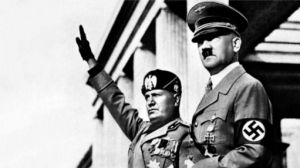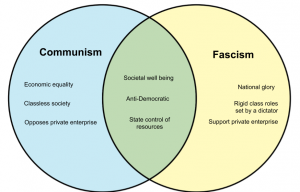Difference between Communism and Fascism
Communism is a system based on the theory of economic equality and advocates for a society where there is no differentiation between the wealthy and the poor. In contrast, fascism is based on a top-down system with rigid class roles which is led by a dictator. The theory of communism originated from Karl Marx and Friederich Engels in their 1848 book, “The Communist Manifesto”. They proposed a communist system whereby all property is communally owned by a classless society. They believed this would solve all societal problems caused by inequality and exploitation. Fascism is based on the glory of a nation. It originated from the nationalist movements of the late 19th century. Fascist regimes are commonly characterized by extreme militaristic nationalism as well as economic policies that favor the rich and opposition to parliamentary democracy.
Both communists and fascists are against the democratic system. However, fascist leaders like Hitler and Mussolini participated in a political election before becoming complete dictators. Communists on the other hand are more in favor of democracy. Communists believe that social classes should not exist and that private property should be seized for control by a communist government. They are also against rigid gender roles.
From an economic perspective, communists are totally anti-capitalist who favor equal wealth distribution and advocate for everyone getting an equal share from labor. Fascism supports private enterprise but its main goal is to glorify the state. The well being of society as a whole is favored over individual rights in both social systems. Countries like China, Cuba, and North Korea are mostly known for practicing communism. However, China has adopted a basic capitalist system to grow their economy. No country is known to be practicing fascism but Neo-Fascists exist in countries like America.
| Communism | Fascism | |
|---|---|---|
| Philosophy | Moving away from possession based on individual ability towards public ownerships that serves everybody’s needs. | Necessitates state glory through the relentless pursuit of conquest and war. |
| Key elements | Dictatorship, planned economy, no private property, common ownership of production tools. | Social Darwinism, Idealism, planned economy, centralized government, anti-democratic, extreme nationalism, racism. |
| Key Proponents | Karl Marx, Fidel Castro, Friedrich Engels, Che Guevara, Peter Kropotkin, Joseph Stalin, Ho Chi Minh. | Adolf Hitler, William Dudley Pelley, Benito Mussolini, Primo de Rivera, Francisco Franco, Oswald Mosley, José Antonio Corneliu. |
| Political system | Although never practised, a communist political system will be classless and stateless, were people govern directly. | Cronyism is common. A fascist political system features an enigmatic leader with absolute authority. |
| Private Property | Abolished. | Nominally permitted. |
| Social structure | Class distinctions eliminated. | Italian Fascism involves a rigid class structure whilst German Nazis emphasized racial superiority with no classes. |
| Economic system | Grounded in material abundance, production tools and capitall are publicly owned. | A Fascist economy is characterized by mega scale public works, deficit spending and strong dissonance of globalization. |
| Political movements | Marxism–Leninism, Marxist Communism, Eurocommunism, Leninism, Maoism, Stalinism, etc. | Nazism, National Socialism, Falangism, national-Bolshevism. Strasserism, neo-Nazism, etc. |
| Religion | Abolished | State Worship (Civic Religion). |
| Free choice | By collective "vote", or the government makes a public decree for the citizenry. | Citizen submit to leadership decisions. |
| Way of change | Government led. | Government led. |
| Means of control | There is no state control in theory. | Direct force. |
| View of war | Anti-war, although it is believe that war boosts economic growth. | Pro-war as it boosts national morale. |
| Example | USSR (1922-1991), China, Cuba, North Korea, Russia and Laos. | Chile (1973-1990), Argentina (1946-1955). |


